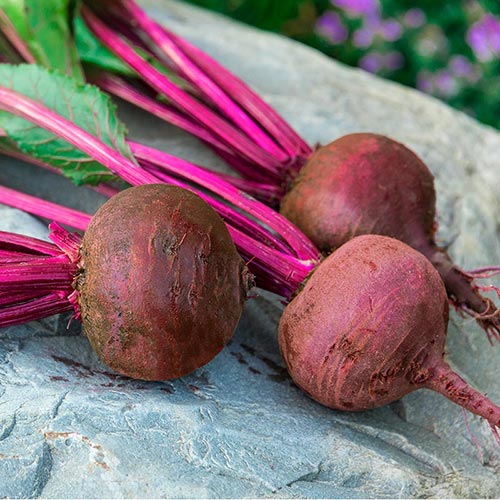It’s no secret that we love beets in our house. And it’s not just the root- we love the whole beet plant, from root to leaf, and because we use so many beets, I’m thankful that we can get two crops a year. We juice beetroots and beet leaves, sauté the beet greens to have with chicken or pork, and roast the beets to add to salads or sprinkle with feta and a little red onion for a side dish. But by far, adding beet juice to smoothies is my favorite way to use up our beets. Packed with antioxidants, beets also have anti-inflammatory properties, making them a great choice for athletes and active adults.
Beets are a cold-weather crop, meaning for most of the growing zones, you can plant your first crop in March or early April when your soil temperature reaches 50° F, with a second crop going in around July or early August. Because beets can survive frost and near-freezing temperatures, they are an excellent choice for Northern gardeners and can be found at most farmer’s markets in the Midwest all the way into December. In zones 9 and above, you can continue to grow beets all winter long.
Beets do need a bit of care and attention, so growing is not as hands-free as beans. Soil needs to be moist, and once the seeds germinate, they must be thinned (pinch off versus pulling, as pulling can disturb nearby seedlings). Once they are thinned I like to get my kids involved and do a light mulching; beets need soil moisture to get big and sweet. From there, though, we leave the beets alone and do very little because beets have such shallow roots and we don’t want to bother them. Most varieties of beets are mature in 50 to 70 days, and I was always taught to harvest before the greens are above 6 inches. I think this ties into the Old Farmer’s Almanac my grandmother used, and has to do with keeping your beets from getting too large and woody. Check the information on the variety you chose, though, as some beets do have naturally longer greens than others. You can store fresh beets in your fridge for up to a week, or can, pickle, or freeze them for later. One tiny little fun beet fact- besides using them for juicing and eating, beets make an amazing natural dye and are a great indicator of soil pH (beets must have a soil pH above 5 or their growth can be affected).
Gurney’s has a great selection of beets- the best by far is our Perfected Detroit Beet. Uniform, gorgeous color, and sweet as candy, these beauties are ready for harvest 58 days from planting in full sun. Perfect for all of your beet needs- juicing, canning, pickling, eating- this variety likes a neutral soil pH (7) and grows to about 3 inches in diameter.
For a bit of a different beet shape, check out the Forono Beet. The long, cylindrical shape makes this a great slicing beet, perfect for salads or sautés. This variety has small, sweet tops and will stay soft and juicy even if you have to delay harvesting. Ready for harvest in 60 days, loves full sun, and especially likes a neutral pH and deep, sandy soil, this variety is a great choice if you are ready to venture away from traditional beets such as Harrier and Detroit.
Interested in more beet varieties? Check out Gurney’s selection of beet seed packets and seed tape and let us know what your favorites are, and any tips you have for growing beets in your region!


